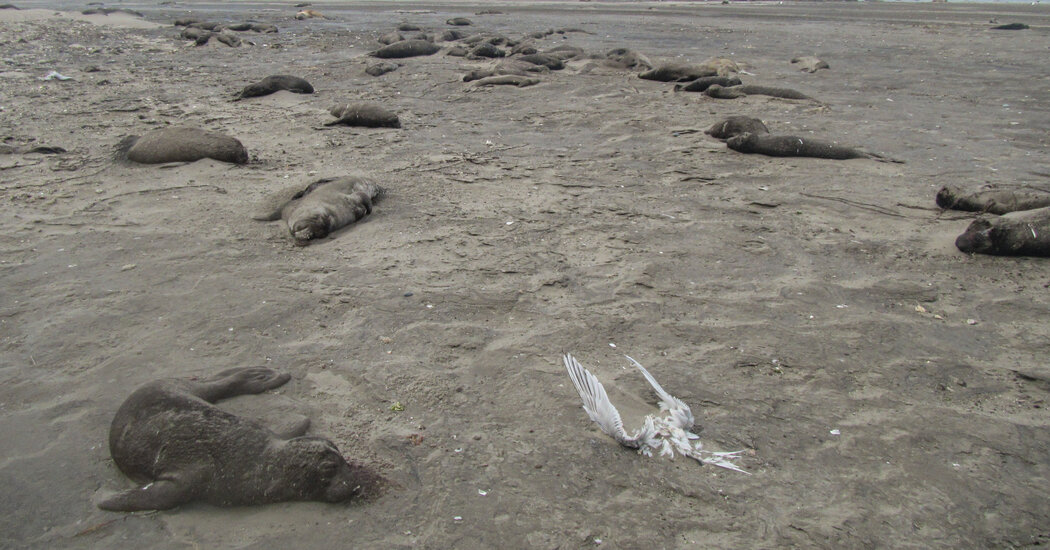
South American elephant seals have died in large numbers because the avian influenza virus acquired mutations that allowed it to spread among mammals, according to a new study.
The research offers the first genetic and epidemiological evidence of avian influenza virus transmission between mammals. And the findings contain a warning: The virus, called H5N1, could similarly mutate to cause large-scale infections in other mammal species, including people.
The avian influenza virus is responsible for an ongoing epidemic among dairy cows in the United States. Since March it has been detected in cows in nine states and in wastewater in several others.
The virus may already be spreading from cow to cow, but federal officials have said the most likely explanation for the outbreak is that it is spreading through contaminated milk.
The H5N1 virus is also presumed to have spread among mink on a farm in Spain. But the new study is the first to piece together several streams of evidence confirming mammal-to-mammal transmission.
The study was published online Saturday and has not been peer-reviewed. But genetic analysis of the virus, and the extent and timing of infections in marine mammals in South America, all suggest that the animals acquired the virus from each other, not from infected birds, the researchers said.
“It's a combination of facts that presents compelling evidence for the existence of some sort of mammal-to-mammal transmission,” said Marcela Uhart, who led the new study and directs the Latin American Wildlife Health Program at the University of California, Davis.
In 2022 and 2023, H5N1 killed more than 30,000 sea lions in Peru and Chile, along with some porpoises, dolphins and otters. He traveled along the Pacific coast and then up the Atlantic coast through Argentina, Uruguay and Brazil.
Last October, a “virus tsunami” occurred in Argentine Patagonia that wiped out more than 17,000 elephant seals, Dr. Uhart said, adding that these numbers make it unlikely that the virus jumped from bird to bird each time. marine mammal.
Mammal-to-mammal transmission is “almost the only explanation for how it spread across the entire southern tip of the continent and has continued to spread,” he said. “Honestly, there aren't many other ways this could have happened.”
In the new study, Dr. Uhart and her colleagues studied virus samples from baby elephant seals and terns. Their genetic analysis suggests that H5N1 jumped at least three times from wild birds to marine mammals on the Pacific coast of South America, and then evolved to spread among elephant seals.
The team presented some of this data in small meetings, but other researchers were resistant to the idea that marine mammals were infecting each other, Dr. Uhart said.
Some scientists have suggested that the mammals had all been infected by the birds. But most of the terns died about three weeks after the mass deaths of sea lions and elephant seals.
Indeed, Dr. Uhart and her colleagues found evidence suggesting that the virus jumped from marine mammals to birds – an unwelcome development, because infected birds can shed the virus wherever they migrate.
Researchers found the H5N1 virus in the trachea, lungs and brains of marine mammal carcasses. It is unclear whether the virus spread through the air or some other route. But in laboratory experiments, the virus has been shown to be transmissible through the air and through direct contact between ferrets.
Researchers found that the avian influenza virus taken from marine animals contained 18 mutations that allowed it to infect and spread more easily among mammals and increased the severity of the disease.
“The huge number of mutations” is a cause for concern, said Dr. Malik Peiris, a virologist and avian flu expert at the University of Hong Kong, who was not involved in the work.
In contrast, there are almost no mutations in infected cows that represent adaptation to mammals. “But it could be a matter of time,” Dr. Peiris said.
None of the mutations were found to affect hemagglutinin, or HA, the viral protein that attaches to receptors in humans and animals. Other studies have suggested that changes in HA are crucial for H5N1 to spread between people and may precede mutations in other parts of the virus.
But “even if the HA has not changed, there are other mutations that could be of concern,” said Agustina Rimondi, a virologist at the INTA-CONICET virology institute in Buenos Aires, who conducted the genetic analysis.
Each infection gives the virus new opportunities to evolve and acquire mutations that could allow it to infect people more easily, he said.
Among the mutations found in the marine mammal virus are two, D701N and Q591K, which alter an enzyme that the virus needs to replicate. Both mutations are believed to be alternatives to another mutation called E627K, which is thought to be a key change needed for the virus to infect mammals.
The mutations merit further investigation, but they may not be followed by the necessary changes in HA and do not necessarily portend transmission between people, said Richard Webby, an influenza expert at St. Jude Children's Research Hospital, who was not involved in the work.
“Changes in HA receptors make it easier for others to emerge, but I don't think it works the other way around,” he said.
Dr. Webby cautions against thinking of all mammals as a homogeneous group.
“I don't think marine mammals are the same as humans, in terms of susceptibility,” he said. “Perhaps replication in marine mammals does not make the virus any more capable of infecting humans.”
